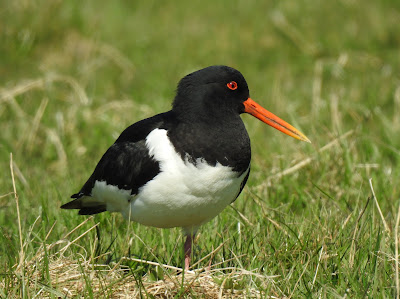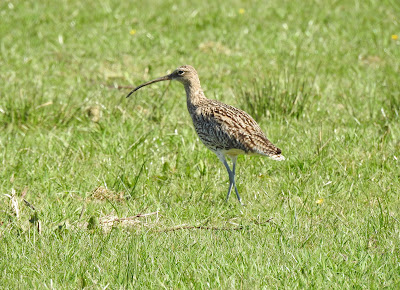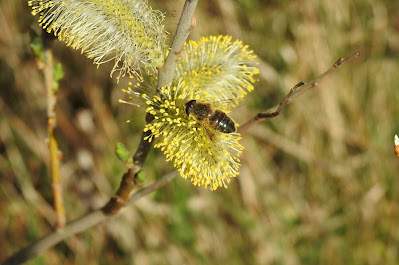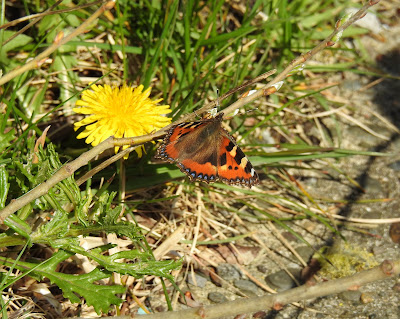It was a glorious morning on Thursday in Bowland when myself and two colleagues and Friends from the RSPB set off to do a breeding wader survey on my client's farm. We weren't surveying the whole of the farm, mainly the better areas for breeding waders, and the areas where we have carried out considerable habitat management. Nevertheless, we had about ten fields each to survey, so it was going to take a few hours.
I recorded five species of wader in the fields that I was surveying; Oystercatcher, Curlew, Lapwing, Redshank and Snipe. Some of the Oystercatchers had paired up in suitable habitat, and others were still flocking, including a flock of at least fifteen birds in the wetland complex. It was hard to work out what these birds were doing. Were they migrants, or were they non-breeding first year birds/ Anyway, I got a shot or two of some of these birds in the sunshine (see below), and I enjoyed watching the antics of some of them, particularly when they were preening.
I had at least four Curlews displaying, and others were flying around in pairs. It's amazing how many fields they cover when they are displaying, so it is hard to pin them down to a particular field until they are on a nest. I didn't think any of the birds I recorded had laid any eggs as yet. Below is a shot of a Curlew that was foraging in a field away from one of the usual fields that they nest in.
On my patch I had about six pairs of Lapwings, and several individuals were displaying and behaving territorially, alarm calling and chasing off any Gulls that dared to fly to low enough. Gavin also found two nests, each with four warm eggs in, so that was good news.
We don't have any livestock on the farm during the nesting period of April - June, and we have also stopped supplementary feeding them outside. And this has reduced the number of predation events from Gulls substantially. We also mow any meadows late, after the end of July and after they have been checked for Curlews by me, and John, who does our mowing for us, mows very slowly and not with a huge triple mower. The slow speed of mowing doesn't attract any Gulls, and also John is very switched on, and manages to avoid anything he sees. This has made a huge difference to the Curlew population.
I only had s single Redshank in a field that we have created lots of scrapes in, see picture below. So, it was hard to know what it/they were up to. Our next survey in May will be more informative.
and I didn't get all the scapes in the shot, but I think you get the picture.
I just had one Snipe, and this was a bird drumming over some very suitable habitat where they breed most years, so that bodes well.
Raptors were thin on the ground, with just a single Buzzard and male Kestrel. I did have stonking views of a Barn Owl hunting around the rank grassland surrounding a pond, a good two hours after sunrise!
Willow Warblers were very vocal, and I had at least nine singing males from the hedgerows. The only other warbler I had was a singing Blackcap. I had a few Lesser Redpolls and Siskins over, and ones and twos of Swallows moved east.
It was a pleasant way to spend the morning, and I look forward to the next survey in May.
Talking of waders, I was fascinated to read about another record-breaking Bar-tailed Godwit. This Bar-tailed Godwit has set the world record for the longest non-stop migration, after flying for 13,560 km (8,426 miles in old money) continuously from Alaska to southern Australia! The five-month old bird undertook the voyage without stopping for 11 days and one hour to reach Tasmania. This means that it must have been averaging 51 kmh, or 31 mph, throughout the journey. Staggering!
According to the data from the Max Planck Institute for Ornithology's bird tracking project, the bird set off from Alaska on 13th October 2022, and took a route to the west of Hawaii, continuing over open ocean, and flying over the Pacific island nation of Kiribati on 19th October 2022. Two days later it flew over Vanautu, and continued south taking a route 620 km east of Sydney over the Tasman Sea, between Australia's east coast and New Zealand. On 23rd October, this amazing bird took a sharp turn and headed west to arrive in Tasmania on 25th October. How about that?!
























